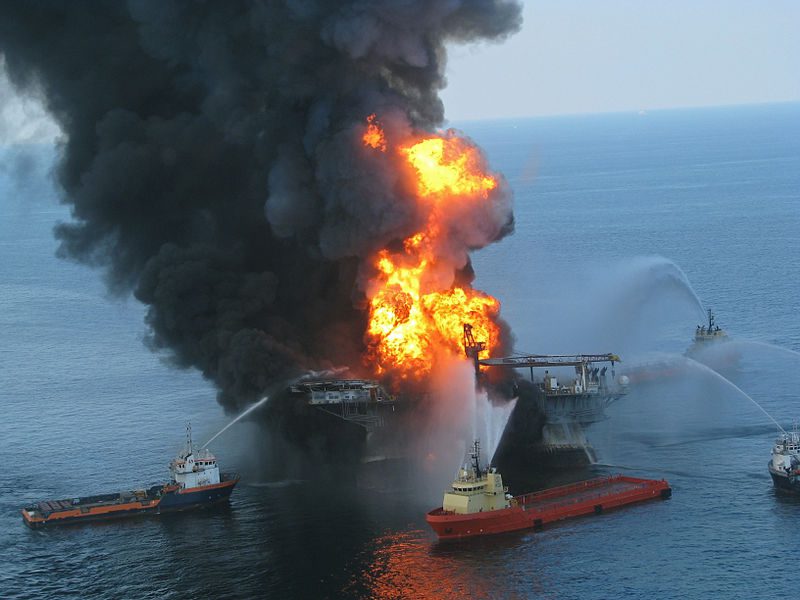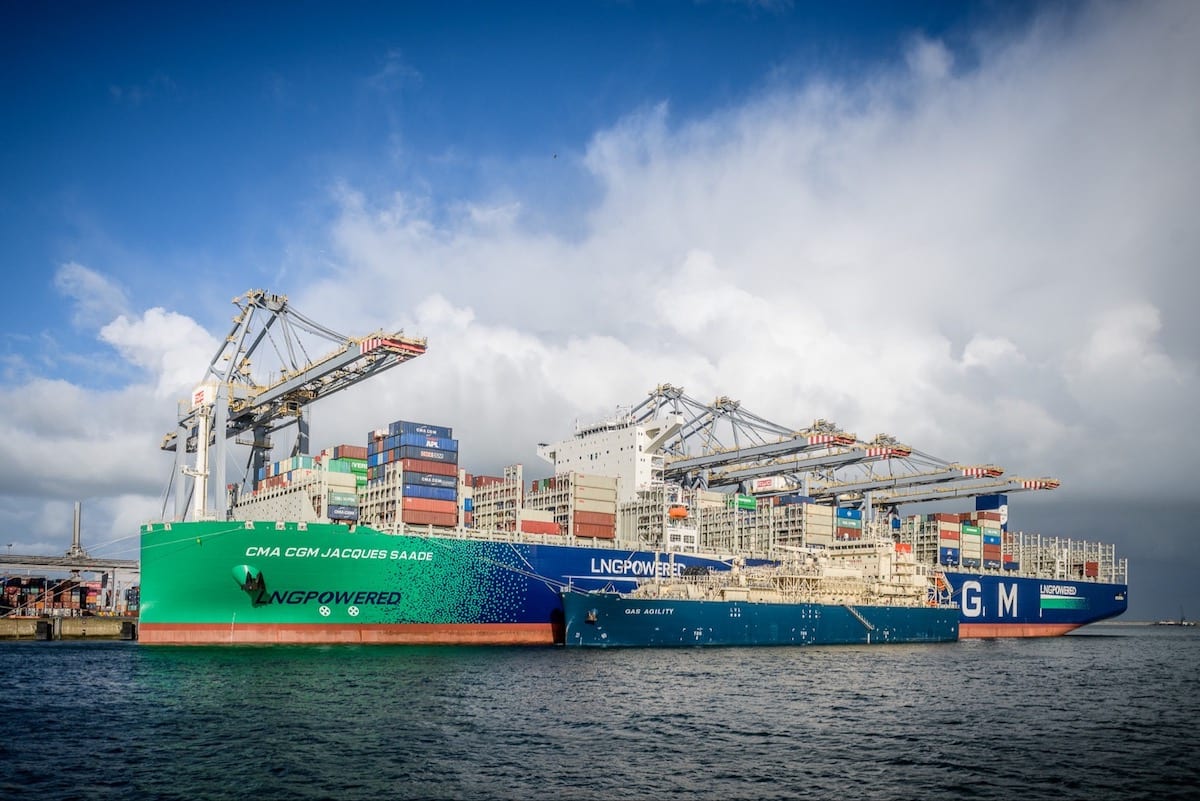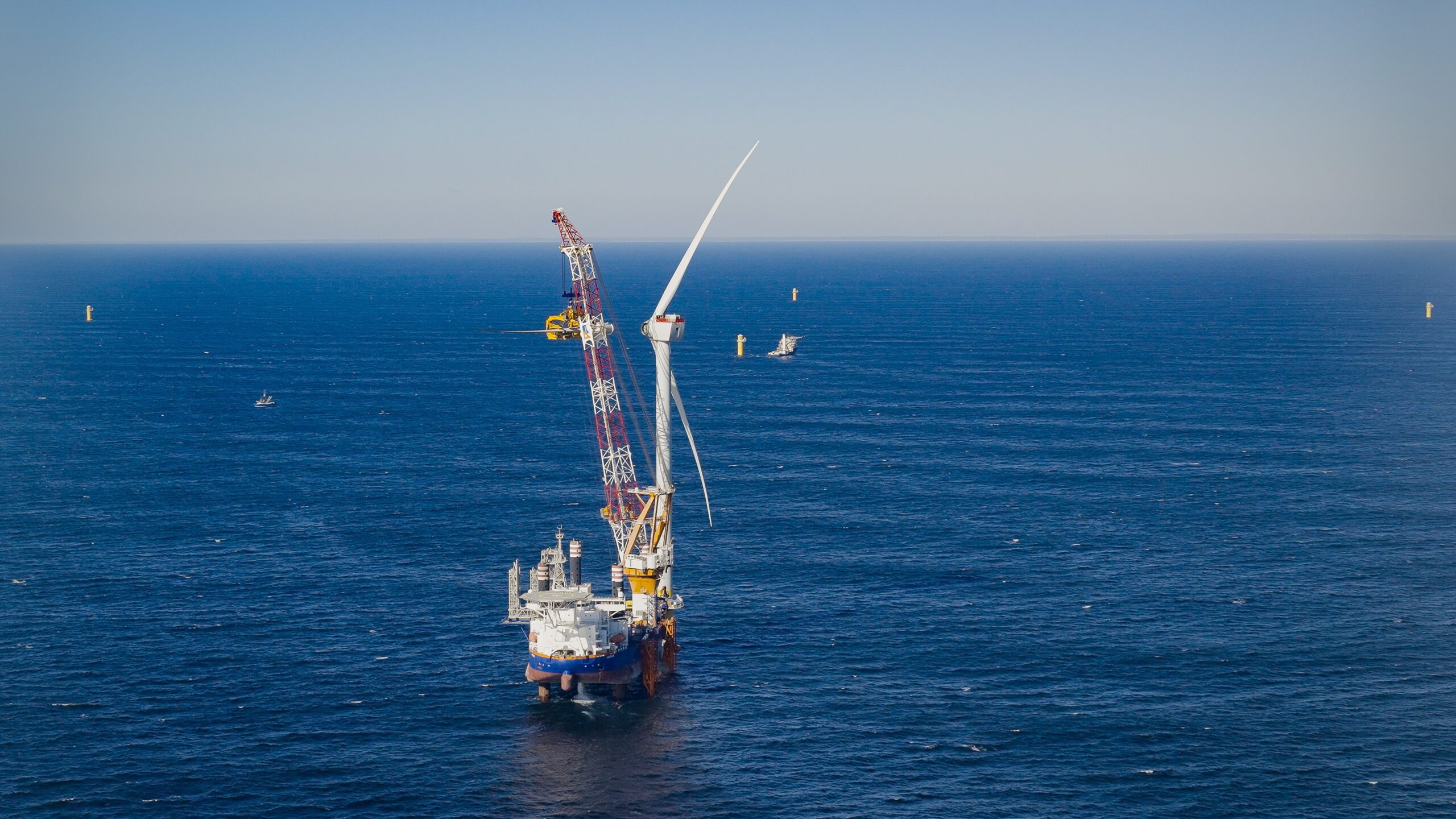US Coast Guard image
By Margaret Cronin Fisk, Jef Feeley and Laurel Brubaker Calkins
(Bloomberg) — Halliburton Co. may escape paying billions of dollars in damages for its role in the biggest offshore oil spill in U.S. history thanks to statements by a witness for codefendant BP Plc.
Halliburton is accused by victims of the Gulf of Mexico spill, and by codefendant companies including BP, of doing defective work on the Macondo well, scene of the 2010 environmental catastrophe.
Next week, a federal judge will begin hearing evidence in a trial in New Orleans federal court where blame for the disaster will be apportioned among the companies that worked on the well. In pretrial testimony, a witness for U.K.-based BP, which owns the well, testified that Halliburton, which provided cement services, didn’t have a chance to avert the oil rig’s explosion. Instead, he placed potential responsibility on BP and rig owner Transocean Ltd.
The blast might have been avoided if a “well-integrity test” by BP and Transocean hadn’t been misinterpreted, J.J. Azar, BP’s engineering expert, said in a deposition, according to a sealed transcript obtained by Bloomberg News.
The so-called negative-pressure test was supposed to determine whether cementing had sealed off any leaks in the well. It was interpreted as proving the procedure had been successful when it wasn’t, Azar testified.
‘Negative Test’
“If the negative test had been correctly interpreted by BP and Transocean and a determination was made that the cement job was not a good job, remediation work could have been done that would have resulted in this blowout not occurring,” Halliburton’s lawyer Don Godwin said. “Would you agree with that?”
“I would agree with that, sir,” Azar replied.
Azar also agreed with Godwin that BP had the final say on whether the cement job needed to be corrected, according to the deposition.
“My client was not given an opportunity to go in and correct anything that might have been wrong with the cement job because the negative test was misinterpreted,” Godwin said. “Isn’t that a fact, sir?”
“That was a fact,” Azar replied.
The Blowout
The blowout and explosion aboard the rig, the Deepwater Horizon, killed 11 workers and spilled more than 4 million barrels of oil into the Gulf of Mexico. The accident sparked hundreds of lawsuits against London-based BP, Houston-based Halliburton and Vernier, Switzerland-based Transocean.
Azar’s testimony, along with a pre-trial ruling barring victims of the disaster from collecting compensatory damages from Halliburton, may allow it to avoid paying damages, said David Berg, a Houston oil-and-gas litigator not involved in the case who has followed the spill suits.
“There could be a finding of some liability against Halliburton, but I don’t see anything that rises to the level of punitive damages, and that’s the only way that Halliburton has to pay,” Berg said in a phone interview. “Halliburton should walk away from this.”
Halliburton would be liable for only punitive damages stemming from the spill. The contract between the companies tied to the Deepwater Horizon required BP to cover any compensatory damages assessed against Halliburton, U.S. District Judge Carl Barbier, who oversees the spill cases, ruled last year.
Compensatory damages pay victims for losses and injuries. Punitives are used to punish defendants for reckless behavior.
Gross Negligence
Azar’s testimony may make it harder for victims, and codefendants, to prove Halliburton acted with gross negligence, a requirement for punitive damages, said Anthony Sabino, a law professor at St. John’s University in New York who specializes in complex litigation.
“Gross negligence requires a much higher standard” of proof of indifference or “incredibly reckless behavior,” he said.
“The real sticky wicket is when your own expert takes a position that is adverse to you,” Sabino said. “The expert will try to explain
it at trial, but the genie is out of the bottle. It’s well-nigh impossible to change it at trial.”
Azar’s deposition was taken in December 2011 in preparation for his role as a potential BP trial witness. Lawyers for Halliburton and the U.S. Justice Department cross-examined him on the causes of the explosion.
Halliburton took a $300 million charge last year for loss contingencies arising from the multidistrict litigation over the blast and spill.
‘Substantial’ Arguments
“We continue to believe that we have substantial legal arguments and defenses against any liability and that BP’s indemnity protects us,” Halliburton said this month in a filing with the U.S. Securities and Exchange Commission. At the same time, the company said, it “cannot conclude that a probable loss associated with the MDL is zero.”
Beverly Stafford, a spokeswoman for Halliburton, declined to comment on potential liability stemming from the trial.
Halliburton fell 85 cents, or 2 percent, to $40.77 in trading in New York. Halliburton shares have gained 10 percent in the past year.
The plaintiffs injured by the spill claim Halliburton acted with gross negligence in using an inappropriate cement mixture for the well. BP also accused Halliburton of withholding information about the job.
“We believe the evidence will show, consistent with all official investigations, that the accident resulted from multiple causes, involving multiple parties, including Halliburton, who failed to pump a stable cement job,” Scott Dean, a spokesman for BP, said in an e-mailed statement.
The Disaster
Halliburton contends its work wasn’t faulty and said the disaster was caused by BP overriding its advice.
Next week’s trial won’t address the dollar amount of damages to be paid. The proceeding will instead focus on establishing who was at fault, and how much, and whether any of the companies involved in drilling the well acted with gross negligence or reckless indifference.
A second trial on efforts to contain the spill is set for September. One or more trials on damages will follow, barring any out-of-court settlements.
The Feb. 25 trial is the latest in a series of legal chapters spanning the three years since the disaster.
The plaintiffs include businesses, casinos and residents who weren’t part of an earlier $8.5 billion settlement. Also suing are companies claiming damages from the resulting federal moratorium on deep-water drilling prompted by the spill. Additional claims addressed by the trial include those filed by state and local governments, and by the U.S. for civil violations of the Clean Water Act.
Some Settled
All private plaintiffs, including those who settled with BP, as well as state and local governments, are pursuing claims against Transocean and Halliburton. Barbier ruled last year that Transocean didn’t have to pay compensatory damages for spill claims because of the indemnity provision in the drilling contract.
In the criminal case, BP pleaded guilty to 14 federal charges, including 12 felonies, and admitted it misinterpreted the critical pressure test just before the explosion. The U.K. company agreed to pay $4 billion in fines and penalties, plus $525 million to settle an SEC claim that the company underestimated the size of the spill.
BP Settlement
BP settled lawsuits by most non-government plaintiffs in March, agreeing to pay an open-ended amount it most recently estimated at $8.5 billion. The plaintiffs, including many businesses and people harmed by the spill, didn’t settle with Transocean or Halliburton.
Separate from its criminal prosecution, the U.S. government sued BP and Transocean for violations of the Clean Water Act and the Oil Pollution Act, seeking fines, cleanup costs and natural- resources damages. BP and the government agreed that 810,000 barrels of oil wouldn’t be included in Clean Water Act fine calculations, since the company was able to capture it before it entered Gulf waters.
The agreement cut BP’s highest potential government fine by $3.4 billion since each barrel spilled can cost as much as $4,300 under the law, depending on the degree of negligence assigned to BP at trial. BP has denied being grossly negligent.
A finding of gross negligence could lead to a potential maximum civil pollution fine for BP of about $17.6 billion.
Well Partners
The government also sued BP’s partners in the well, Anadarko Petroleum Corp. and Mitsui & Co.’s MOEX Offshore 2007. MOEX settled the lawsuit last year, and Transocean last month settled all but the natural-resources claims.
As part of Transocean’s accord, it pleaded guilty to a misdemeanor Clean Water Act violation and agreed to pay $1.4 billion, including $400 million in criminal penalties.
The U.S. didn’t sue Halliburton, another sign that the company may be able to skirt paying damages, Berg said.
“The very fact the government didn’t come after them is very strong evidence of a lack of liability,” said the lawyer, author of the book “The Trial Lawyer: What It Takes to Win.”
Halliburton was hired to seal the well to prevent leaks with a specialized cement along its sides and bottom. Without this seal, oil or gas in underground rock formations might enter the well, shoot to the surface and cause a blowout.
BP canceled a “cement bond log,” a test of cement integrity, and rejected a Halliburton engineer’s recommendation to use 21 stabilizers to center the drill pipe in the well, Halliburton alleged in court filings. BP officials’ decision to use six stabilizers increased the risk of a leak, Halliburton said.
‘Kick’ in Well
Halliburton claimed BP failed to disclose an oil or gas zone higher in the well than the targeted production area, which prevented the contractor from designing that zone into the final cement job. If the zone wasn’t properly sealed, it could have leaked, Halliburton said in court papers.
Azar, the independent expert hired by BP, testified that Halliburton’s failed cement job was a direct cause of a “kick,” an entry of gas or fluid into the well, which can cause a blowout.
Kicks are well-known on oil drilling projects and can be controlled so they don’t result in blowouts, Azar said. BP and Transocean had a chance to prevent the Macondo well blowout, he said.
“When you detect a kick, you automatically shut in the well,” the engineer testified, referring to a shutdown. “Once you detect anomaly, you shut in a well and then investigate. And it’s not the other way around.”
‘Few Minutes’
Deciding to stop drilling operations was the responsibility of Transocean and BP, and would have taken “a few minutes, maybe less than a minute,” he said.
Criminal allegations against BP and two of its employees center on the results of the negative-pressure test, a check for an increase in the pressure or flow of oil or gas up the well.
BP personnel realized the negative test was unsuccessful less than an hour before the blowout, Azar said when questioned by R. Michael Underhill, a Justice Department lawyer.
Underhill recounted a telephone call between BP engineer Mark Hafle, onshore at BP’s drilling command center, and site manager Donald Vidrine on the day of the blast, April 20, 2010.
“Mr. Vidrine now has information that that negative- pressure test that he has previously approved can’t be considered a successful negative-pressure test based upon what Mr. Hafle told him, according to this document,” Underhill said.
“Correct,” Azar said.
No Alert
Underhill asked Azar if he had evidence that Vidrine or Hafle informed anyone on the rig after the call ended at 9:02 p.m. to alert them about the unsuccessful test and the potential for a blowout.
“No, sir.”
If the driller, Transocean, had been informed that the test was unsuccessful, its personnel could have shut in the well and established control, Azar said.
Underhill asked Azar, who is co-author of the textbook “Drilling Engineering” and former director of the University of Tulsa Drilling Research Projects, what he would have done.
“If I was right there on that rig site and seen that anomaly, I shut the well down, sir,” he said.
At 9:41 p.m. drilling mud shot out of the pipe connecting the rig to the well on the seafloor. The first of two explosions came roughly nine minutes later.
Manslaughter Charges
Vidrine and another site manager, Robert Kaluza, were indicted on federal charges of manslaughter, have pleaded not guilty and are scheduled to go to trial next January.
Halliburton may be assigned some degree of fault for failing to provide results of all lab tests on its cement formula to BP before the job, Berg said.
BP claims the oil-field services company provided only test results showing the cement worked, while other tests indicated the formula could be unstable under certain conditions.
“That’s misleading for them not to have disclosed all the results,” Berg said. “But it hardly rises to willful indifference to the outcome.”
The same principle applies to Halliburton’s failure to independently confirm the results of the third pressure test on Macondo, which BP and Transocean told Halliburton was a success when it wasn’t.
“I might rip them up for that, the failure to double-check the third test,” Berg said. “But I still don’t hear a gross- negligence claim.”
The case is In re Oil Spill by the Oil Rig Deepwater Horizon in the Gulf of Mexico on April 20, 2010, MDL-2179, U.S. District Court, Eastern District of Louisiana (New Orleans).
Copyright 2013 Bloomberg.
Unlock Exclusive Insights Today!
Join the gCaptain Club for curated content, insider opinions, and vibrant community discussions.

 Join The Club
Join The Club













